| VR Lab POSTER |
VR Lab Brochure |
VR Lab Capability Statement |
| |
|
| |
Megacity: A Collaborative Virtual Reality Environment for Emergency Response, Training, and Decision Making |
 |
We have used game creation as a metaphor for creating an experimental setup to study human behavior in a megacity for emergency response, decision-making strategies, and what-if scenarios. Our proposed collaborative VR environment includes both immersive and non-immersive environments. The participant can enter the CVE setup on the cloud and participate in the emergency evacuation drill, which leads to considerable cost advantages over large-scale, real-life exercises. We present two ways for controlling crowd behavior. The first defines rules for agents, and the second provides controls to the users as avatars to navigate in the VR environment as autonomous agents. |
| |
|
| |
Active Shooter Response and Training for BSU Campus in a Collaborative Virtual Reality Environment (CVE) |
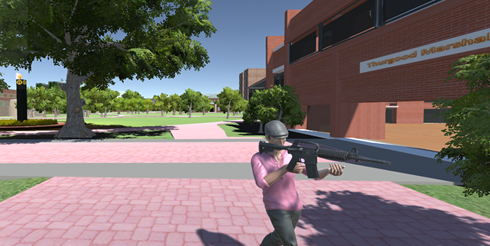 |
The goal of this NSF funded project is to developed and evaluate a collaborative immersive environment in VR for active shooter response for BSU campus. The BSU university campus CVE environment is designed for corner cave and oculus rift head mounted display to give the user a complete immersive experience of the BSU campus.Immersive collaborative virtual reality environment also offers a unique way for training in the emergencies for campus safety. The participant can enter the collaborative virtual reality environment setup on the cloud and participate in the evacuation drills which leads to considerable cost advantages over large scale real life exercises. The contribution also lies in our approach to combining computer simulated agents (AI agents) and user-controlled autonomous agents in a collaborative virtual environment for conducting emergency response training for security personnel's. |
| |
|
| |
Augmented Reality with Hololens: Building Evacuation |
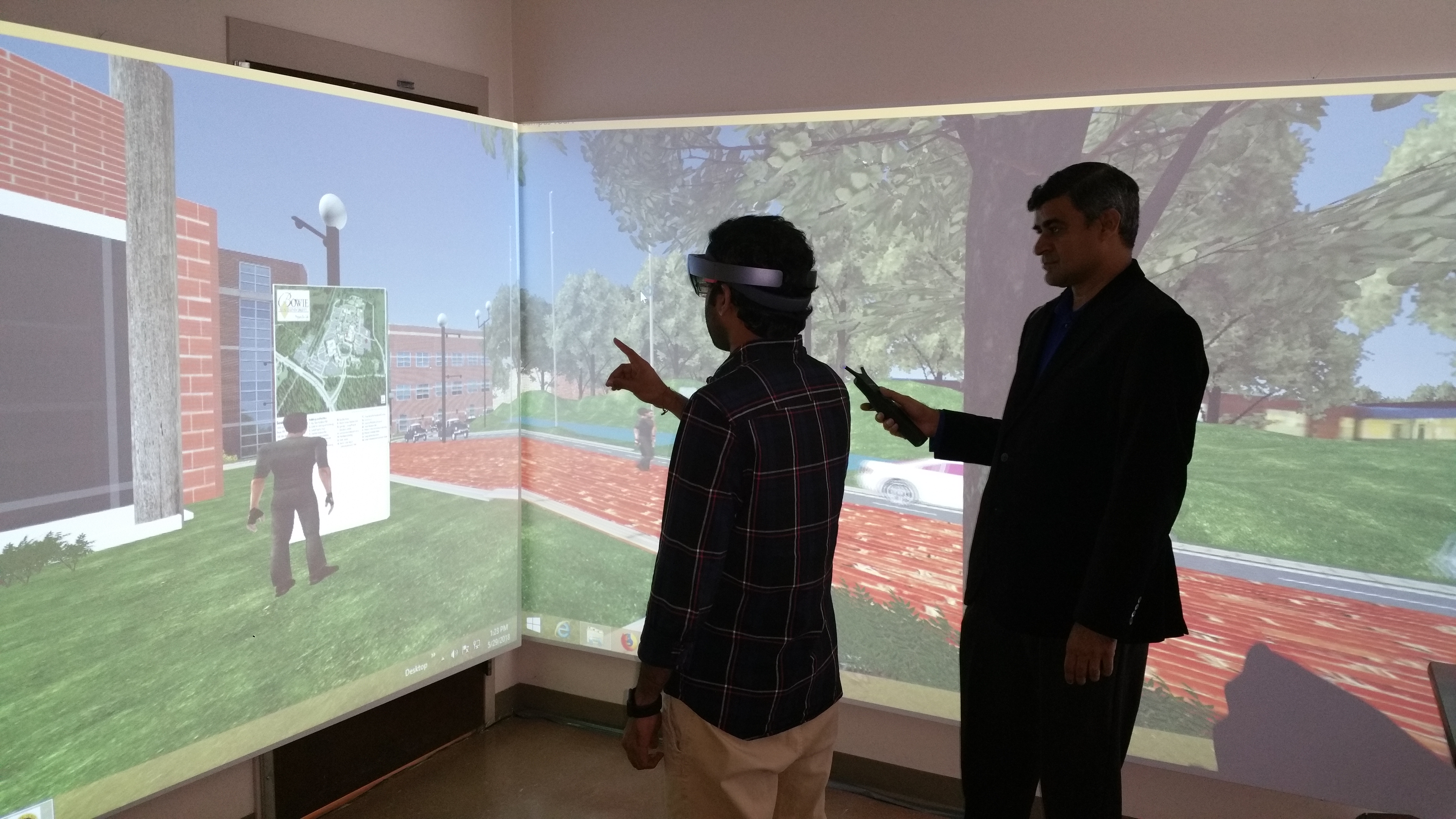 |
Early hands-on experiences with the Microsoft Hololens augmented/mixed reality device have given promising results for building evacuation application. A range of use cases are tested, including data visualization and immersive data spaces, in-situ visualization of 3D models and full scale architectural form visualization. The Hololens is a remarkable tool for moving from traditional visualization of 3D objects on a 2D screen, to fully experiential 3D visualizations embedded in the real world. Our Hololens application gives a visual representation of a computer science building in 3D space, allowing people to see where exits are in the building. It also gives path to the various exits; shortest path to the exist as well as directions to safe zone. |
| |
|
| |
Harnessing the Data Revolution (HDR): Creating and Integrating Data Science Corps to Improve the Quality of Life in Urban Areas |
 |
The goal of this NSF funded project is to develop a team-based data science corps program for undergraduate students from Computer Science, Information Systems, and Business integrating both academic training as well as hands-on experience through real-world data science projects. This project is a collaborative effort with the University of Maryland Baltimore County as the coordinating as well as an implementing organization, and the University of Baltimore, Towson University, and Bowie State University as implementing organizations. This project focuses on the city of Baltimore as an exemplar for other cities in the US and across the globe. The project team will collaborate with a number of communities in the city of Baltimore to integrate real-world data science projects into classroom instruction in data science. |
| |
|
| |
Scientific Data Visualization of COVID-19 Data and Baltimore Crime Data |
 |
The goal of this project is to find common links between COVID-19 data and its relationships with crime data in Baltimore.The aim of the project is to develop scientific data visualization using Paraview, Power BI, DXR, and Unity 3D. Advances in new technologies such as machine learning, virtual reality, augmented reality, and mixed reality have given rise to immersive field of immersive analytics, which investigates how these new technologies support analysis and decision making. We are exploring data sets for location information of crimes that have occurred in Baltimore City dating back to 2012. We will find out reasons as to why the black community is disproportionally impacted during the coronavirus pandemic, compare the COVID-19 data with past recent events for spike in data, time series analysis, and other types of data in Baltimore, such as real estate and school closings. |
| |
|
| |
VAPOC: Visualization, Analysis and Prediction of COVID-19 |
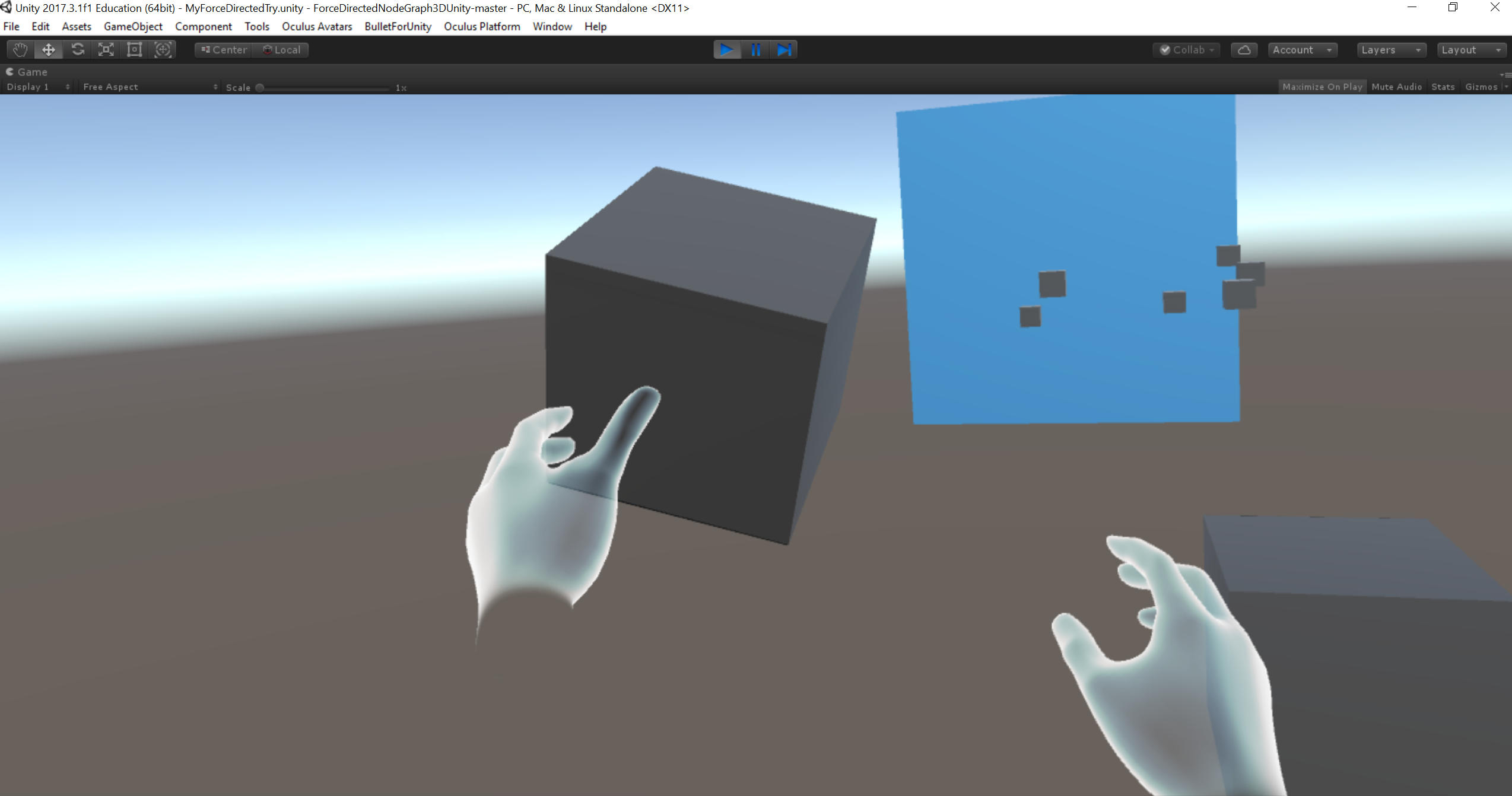 |
The goal of NSF funded VAPOC (Visualization, Analysis and Prediction of COVID-19) project is to find out reasons as to why the black community is disproportionally impacted during the coronavirus pandemic. The VAPOC project combines neural networks predictions with human centric situational awareness and data analytics to provide accurate, timely and scientific strategy in combatting and mitigating the spread of the coronavirus plague in the black community. The project involves development of a visualization and interaction tool to analyze COVID-19 patients' dataset in an immersive and non-immersive environment in accordance with the user's requirements to enhance situational awareness |
| |
|
| |
COVID-19 Virtual Reality Instructional (VRI) Training for Improving Quality of Care and Patient Safety |
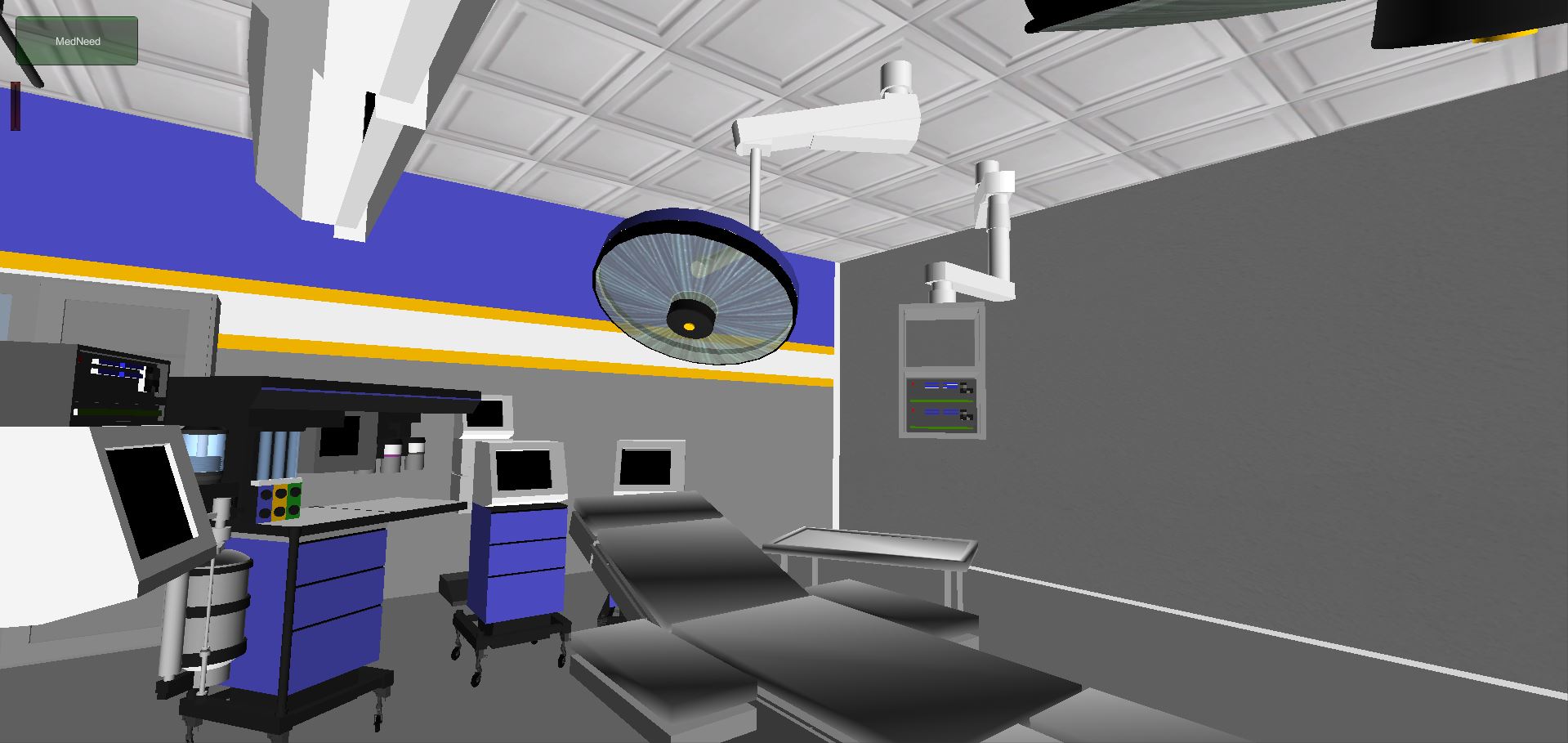 |
Our goal is to develop virtual reality instructional (VRI) modules to train integrated care team members to engage patients from vulnerable populations safely and efficiently. As the COVID-19 pandemic continues unabated, socially vulnerable populations face disproportionate risks as is often the case during public health emergencies. Emerging trends of differential impact on socially vulnerable populations, such as certain racial and ethnic minorities, among others, require urgent attention to improve quality of care and patient safety. This project aims to characterize determinants for improving quality of care and patient safety among vulnerable populations, specifically with a focus on racial and ethnic minorities, and fully incorporate these findings into the creation and development of Virtual Reality Instructional (VRI) training modules geared for integrated care teams to enhance care delivery. Our Collaborative Virtual Reality Environment (CVE) project aims to improve patient experience in healthcare. |
| |
|
| |
Game-theme based instructional (GTI) modules and Virtual Reality Instructional (VRI) module |
 |
The aim of this project is to create instructional course curriculum modules with more inquiry based problem-solving activities and hand-on experiences based on Gaming and Virtual Reality. The game theme instructional (GTI) modules endeavor to increase the students interest in learning programming concepts. However, the GTI modules should be usable and likable to include it in a class curriculum. We have incorporated a virtual instructor to help the users learn the modules. We have evaluated the GTI modules using User Engagement Scale (UES), Theory of Reasoned Action (TRA), and Science Motivation Questionnaire (SMQII) to evaluate usability, likability, and motivation respectively. The result of evaluation shows that the modules are usable, likable, motivational, and engaging. We have creatde VRI modules for arrays, linked list, memory mangament, trees, binary search, stacks, queues, etc. |
| |
|
| |
Human Centric Cyber Situation Awareness and Data Visualization |
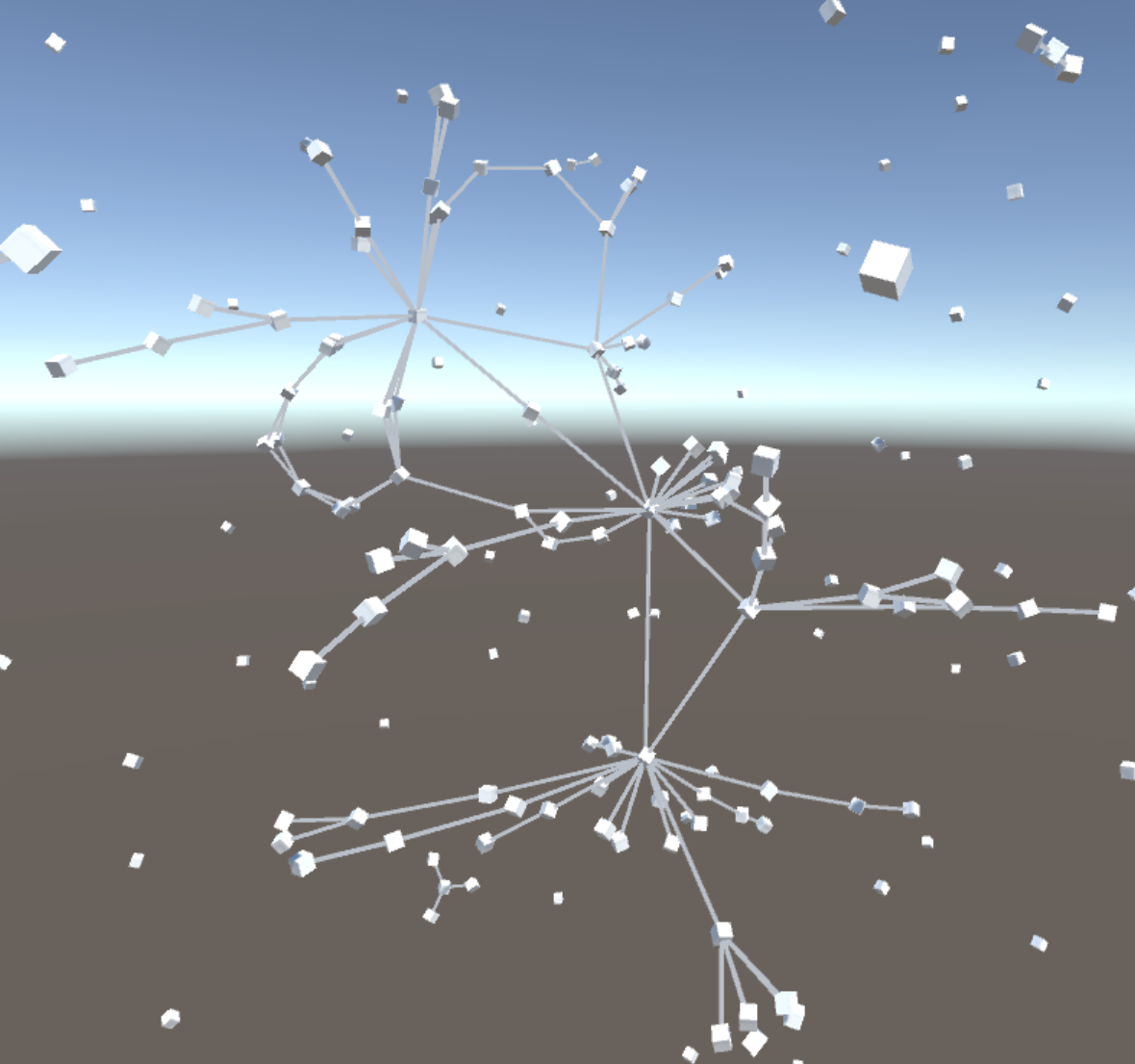 |
The goal of this project is to explore ways to visualize the Cyber Situational Awareness capability of an enterprise to the next level by developing holistic Cyber Situational Awareness approaches into new systems that can achieve self-awareness. A variety of computer and network security research topics belong to the scope of Cyber Situational Awareness. he project aims to use virtual reality techniques to visualize the code metadata generated by sensors through the use of a Force Directed Node Graph in 3D which renders and updates in real-time. It will visualize computer networks for cyber-attacks. |
| |
|
| |
School Bus Evacuation Drills in a CVE (Collaborative Virtual Environment) |
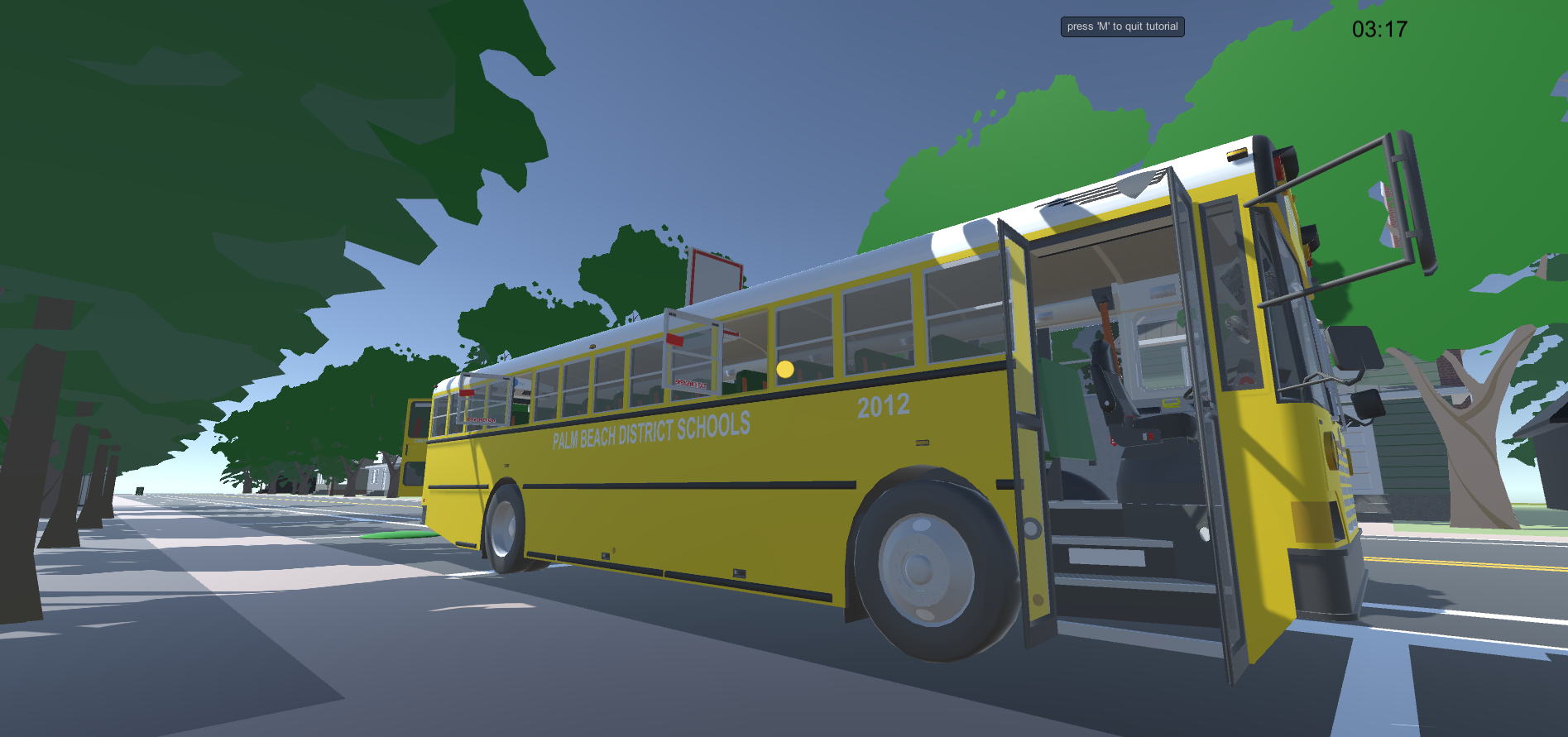 |
Virtual reality experiments with virtual evacuation drills are necessary to study human behavior under emergency situations that cannot be evaluated in the real world. The use of collaborative virtual environments to run virtual evacuation drills for an emergency evacuation eliminates risk of injury to participants and allows for the testing of scenarios that could not be tested in real life due to legal issues and possible health risks to participants. We have developed a collaborative virtual environment (CVE) using Unity 3D gaming engine for performing evacuation drills for a school bus. We have integrated oculus rift touch to interact in the immersive school bus environment. We have demonstrated the School Bus Evauation Drill demo at USA Science Festival for STEM at Walter E. Washington Convention Center, Washington DC on April 7 & 8, 2018. |
| |
|
| |
Real-Time Nightclub Disaster in CVE |
 |
The purpose of this project is to re-create a past events that occurred during the tragedy in a nightclub in Brazil. We can learn a lot from previous disasters which is valuable for accuracy in decision making strategies. The CVE platform acts as a training and educational tool by exploring the environment in Virtual Reality. It also utilized Photon Unity Networking to allow the use of multiple user capability. Our hypothesis is that the CVE would allow learning from existing disasters to prepare for similar events. The proposed CVE should decrease safety risks as well as
allow users to evacuate safely during emergency responses. It allows a user to navigate inside the night club disaster immersive environment using HTC vive and controllers. The user had the ability to start fire and smoke, start evacuation, put of fire, pick up safety cones and place them, and navigate in the environment. |
| |
|
| |
M-Evac: Mobile Augmented Reality Application (MARA) for Navigation in a Building |
 |
M-Evac is a AR application that allows you to view the 3D augmented reality scenes. 3D models are overlaid on the real world as seen through a mobile or computer's webcam, making them appear to part of the surrounding real environment. M-Evac uses marker-based camera tracking such that the 3D models appear attached to physical printed markers. We show how the application is able to display a 3D model of the building using markers and web camera. The system gives a visual representation of a library building in 3D space, allowing people to see where exits are in the building through the use of a smart phone. M-Evac is a Mobile Augmented Reality Application (MARA). The MARA will enale enable policymakers and first-responders to evaluate evacuation strategies and mobile device usage during evacuations. |
| |
|
| |
VR Assembly using HTC Vive |
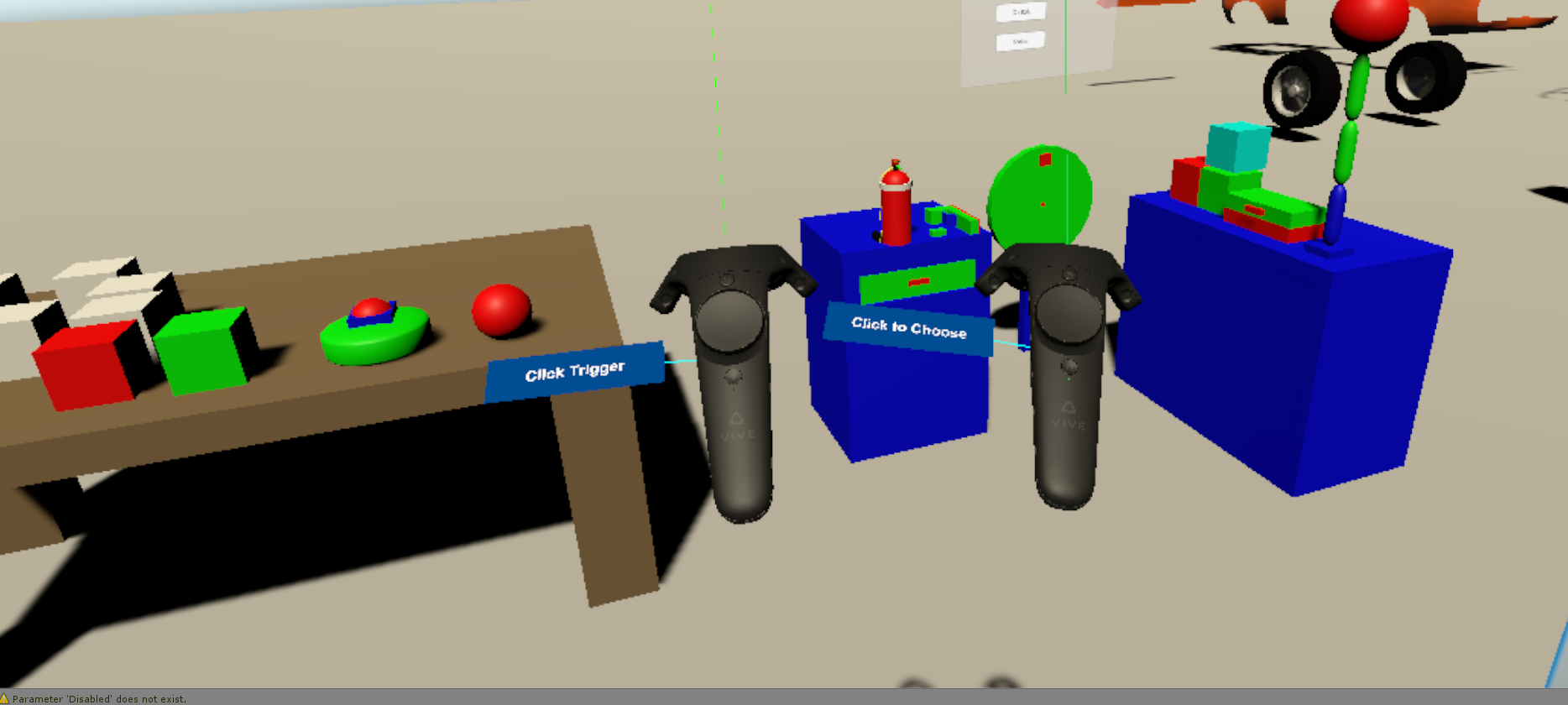 |
The goal of the VR Assembly project is to create a collaborative virtual environment (CVE) for concept design and assembly in VR from a database of pre-defined "parts", enabling engineers and scientists to work in a shared VR environment. This could be part of a concept design or pre-proposal process. The project will contain a data base of a set of physical primitive and off-the-shelf, plug and play parts with reduced detail CAD files. The users will be able to drag and drop the CAD files from the menu to the VR environment for design collaboration. VR assembly project will be used to collaborate, visualize, and check assembly and tool paths without costly 3D printing or manufacturing. We hope our contribution helps in developing the virtual reality assembly or prototype systems. The VR lab has built a VR assembly environment using HTC vive and Unity 3D. |
| |
|
| |
Mobile Augmented Reality Application (MARA) for Building Evacuation Using Intelligent Signs |
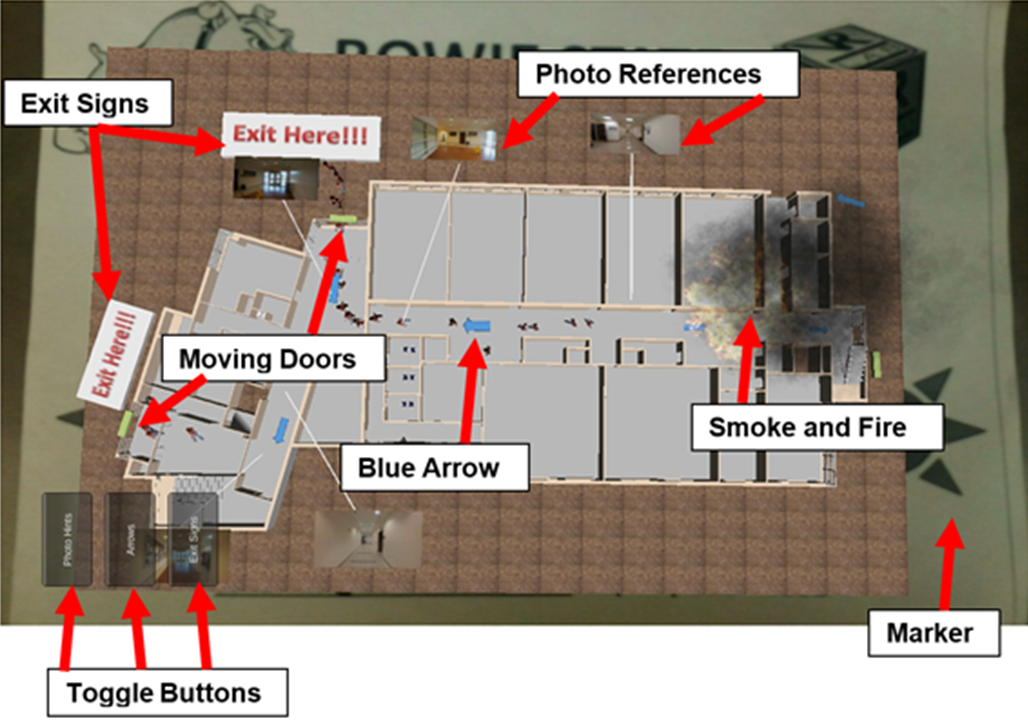 |
Motivated by augmented reality's educational use and mobile technology's ubiquitous presence, an Android-based mobile augmented reality application (MARA) was developed to show people how to evacuate the Computer Science Building at Bowie State University. The application was implemented for Android-based systems using Unity3D and Vuforia. By featuring intelligent signs acting as visual aids, it promises to be effective at helping users determine and visualize the best path to the nearest exit. the MARA was built as an alternative to live evacuation drills using Unity3d along with the Vuforia AR Toolkit and the Android SDK. The uniqueness of this research effort is the inclusion of visual cues, known as intelligent signs, to further assist the user in evacuating the building. Although, the app has been tested out throughout its development, a user study will be performed to evaluate its usability and the effectiveness of the intelligent signs. |
| |
|
| |
Multi‐User Virtual Environment (MUVE) for conducting Airplane Evacuation drills using Gaming Metaphor |
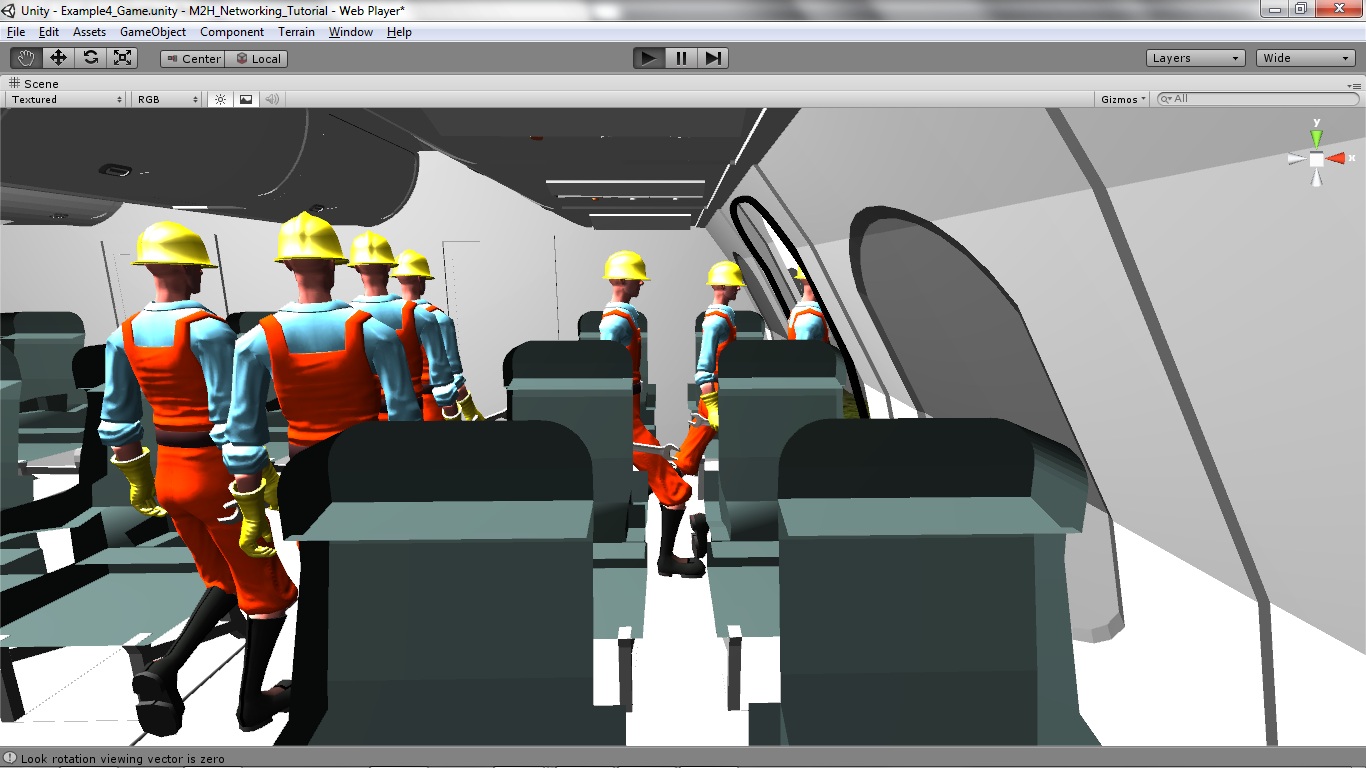 |
Virtual Reality (VR) training has been used for training and education for many years in military and medical fields. We have used game creation as a metaphor in creating an experimental setup to study evacuation behavior for an airplane. Our objective is to create an experimental design setup for assessing human behavior in emergency evacuation of an aircraft among a team of players in a game set in a virtual environment. Also, our aim is to create a multi user environment to allow participants in different geographical locations to connect and be able to interact in the VR environment. |
| |
|
| |
Subway Evacuation Drills in Mult-User Virtual Environment (MUVE) using Unity 3D and Oculus Rift |
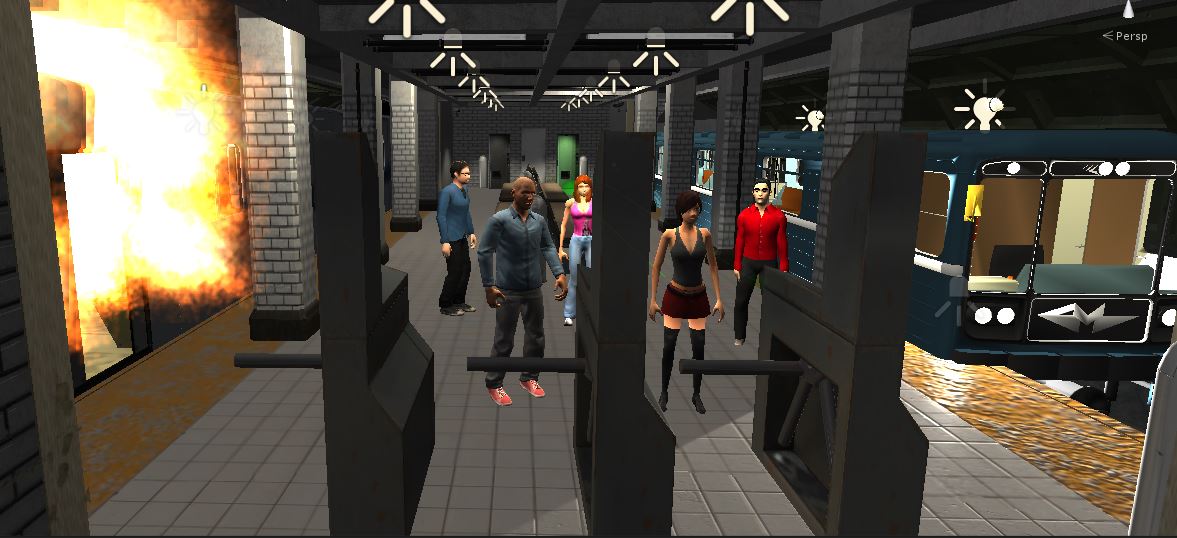 |
People catch the train to get around the city for many reasons, and with so many people using subway trains, emergencies are bound to occur. A virtual multi-user environment can be used to find flaws in evacuation procedure and show passengers a better way to avoid danger in an emergency. Creating a live emergency with real people would be dangerous and unethical. However, creating a virtual emergency with real people is safe and efficient. We have used game creation as a metaphor in creating an experimental setup to study evacuation behavior in a Virtual Reality Multi-User Subway Environment. |
| |
|
| |
Virtual Reality Classroom: A Collaborative Educational
Virtual Learning Environment |
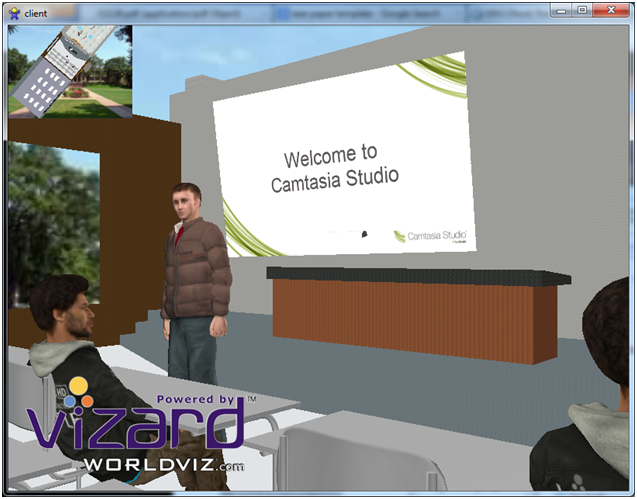 |
This project presents a Virtual Reality Classroom
that is similar to second life. TheVR environment could
be used as an actual virtual classroom where
teachers can interact with students and deliver the lecture. The online virtual
classroom is developed so that students can interact with
each other as well as the instructor. Teachers can also use this
server/client feature for delivering lectures in an online virtual environment. The proposed system is a collection of different Virtual Classroom model environments created in 3DS Max and exported to WorldViz Vizard which constitute the base of this application. Animations and interactivity were added to the environment through a variety of techniques. Currently, on the server side the VR classroom environment consists of eight classrooms with two student lounges with distinct individual textures. |
| |
|
 |
Using Genetic Algorithim and Neural Network for learning and adaptive behavior in a goal finding application
The goal of this project is combining Genetic Algorithm (GA) with Neural Networks (NN) to explore how intelligent agents can look for exits during an evacuation. The agents have the capability to adapt their behavior in the environment and formulate their response by learning from the environment. Our approach focuses on modeling individual behavior as well as group behavior. Individuals constantly adjust their behavior according to the dynamic factors in the environment. We are developing crowd-modeling and emergency behavior modeling capability in a goal finding application. This project examines an intelligent agent-based evacuation that can help plan emergency evacuations, run numerous event-driven evacuation scenarios, support research in the areas of human behavior, and model the movement of responders and security personnel. The result of this simulation was very promising as we are able to observe the agents use GA and NN to learn how to find the various exits. |
| |
|
| |
Past Projects |
| |
|
| |
Urban Emergency Response in a city using Multi-User VR Environment |
 |
The goal of this project is to create a multi-user helicopter training simulation that will aid in the efforts of treating wildfires. The simulation includes various scenarios immolating real-world instances. Real-world instances are in place to develop alternative techniques that may be applied to real life situations. It is anticipated that the user will gain skills and knowledge in the virtual environment that they will then be able to apply to the real world due to the sense of presence and realism a virtual environment can provide. The simulation may be used for both training and educational purposes. The application will track user efficiency and decision making strategies. |
| |
|
| |
Emergency Campus Evacuation Drills in Collaborative Virtual Reality Environment (CVE) using Corner Cave/ Oculus Rift |
 |
The use of multi user virtual reality environment training and virtual tours have been increasingly recognized an as alternative to traditional real-life tours for university campuses. Our proposed application shows an immersive collaborative virtual reality environment for performing virtual online campus tours and evacuation drills using oculus rift head displays. Immersive collaborative virtual reality environment also offers a unique way for training in the emergencies for campus safety. The participant can enter the collaborative virtual reality environment setup on the cloud and participate in the evacuation drill or a tour which leads to considerable cost advantages over large scale real life exercises. |
| |
|
| |
Mobile Application for Campus Tour and Safety using Samsung Gear VR |
 |
This mobile application will enale enable policymakers and first-responders to evaluate evacuation strategies and mobile device usage during evacuations. Our current application shows the interactive virtual campus tour using Samsung Gear VR head mounted display. We have used Unity 3D gaming engine and vuforia pluggin for developing the campus environment. The environment is tested using Samsung Gear VR and Samsung Galaxy S6, and Samsung Galaxy S6 edge. The BSU university campus 3D environment is designed to give the user a complete immersive feeling of the campus. We hope our contribution helps in developing more interactive virtual reality campus environments. |
| |
|
| |
Virtual City: Crowd behavior and traffic intersection problem |
 |
We are developing a crowd behavior capability in a virtual city where there are traffic intersection junctions for people to cross over the road. We will generate a wide variety of civilian individual and group behaviors at differing levels of fidelity. Our simulation will consist of autonomous virtual human agents walking on the side walk in the virtual 3D environment. Agents will have 3D graphic body representations. They will be able to perform certain low-level actions like playing of pre-recorded animation sequences such as gestures or walking to specified location. |
| |
|
| |
Android App for Emergency Response and Surveillance |
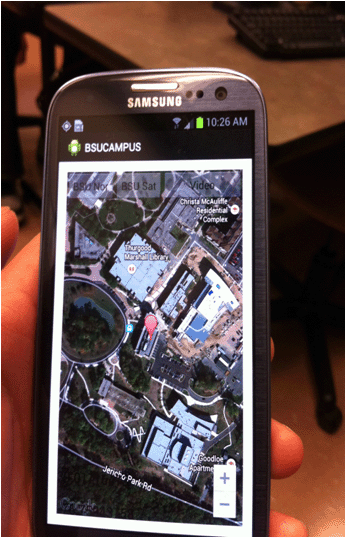 |
The goal of this project is to develop an android application for emergency surveillance at BSU by using google latitude and longitude to determine the location of the user. It will provide safety decision making system for a school/university. We are using Eclipse IDE to add the google map with normal and satellite view into the application with a valid API key. We are also combining the geo-location and location manager with the map to get the current location of the user. Currently we are working on tracking multiple users and integrating augemtned reality markers on the campus map. |
| |
|
| |
Mobile Augmented Reality Application (MARA) System for Navigation, Learning and Campus Safety |
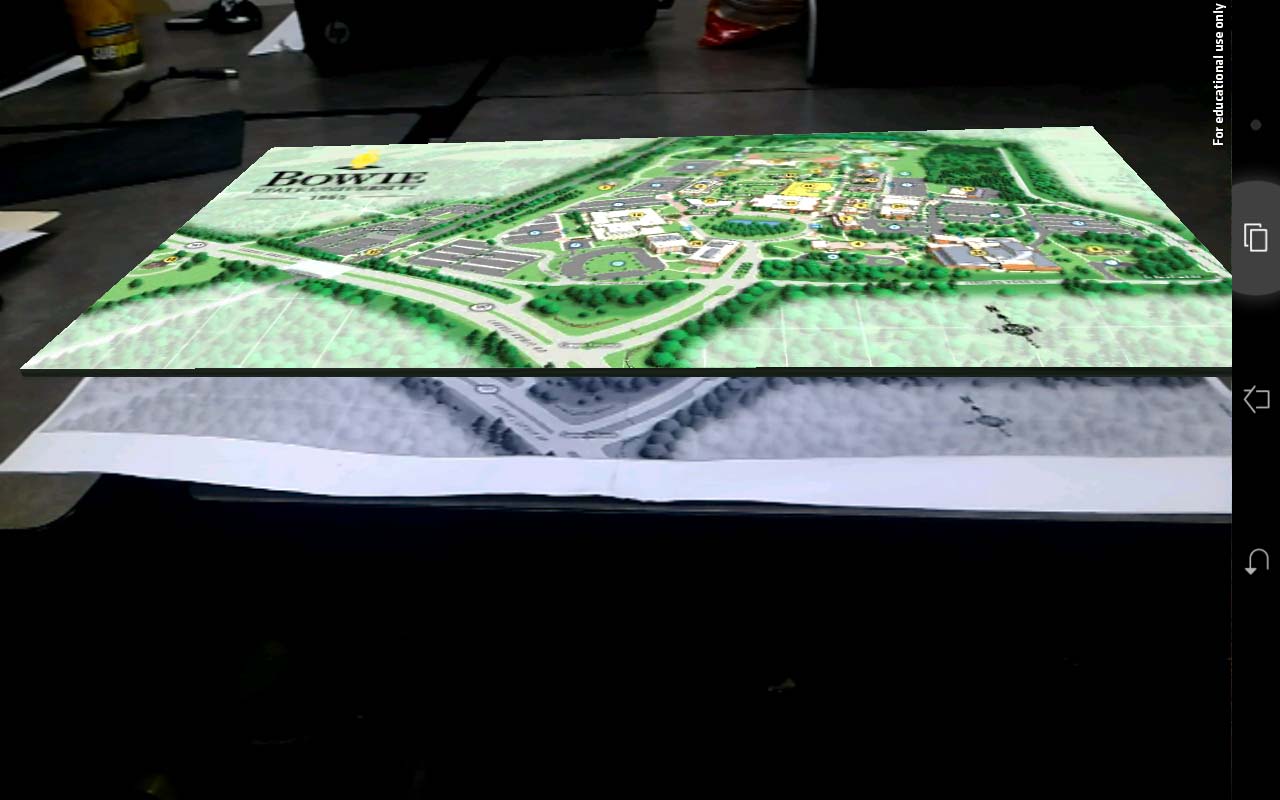 |
The MARA will enale enable policymakers and first-responders to evaluate evacuation strategies and mobile device usage during evacuations. The goal of this project is to use ARTtoolkit to create a emergecny response system to help people evacuate a building. The system that give a visual represrentation of a building in 3D space, allowing people to see where exits are in the building. Our proposed solution would include putting the markers at key spots in the building, such that the user can use their smart phones to view the 3D representation of the building and exits. The proposed systems will use GPS data to generate a geo-spatial representation of the university campus environment that can be navigated and manipulated through augmented reality. |
| |
|
| |
Mobile App for increasing Productivity and Health at Workplace |
 |
Mobile devices and apps provide many benefits for users, perhaps most significantly is the increased access to point-of-use tools. Providing simple exercises with the help of mobile apps allows the user to access and practice exercises at the work place.This project presents a mobile work place fitness application which can increase the productivity and health of the users at the workplace. The proposed mobile application provides an account profile facility to check daily exercise activities and help users to be productive at work. We have added security to the user accounts and profile features that will secure user data and personal health-related records. Our contribution lies in our approach to create a user specific customizable exercise plan in order to improve the health and productivity of the users at their workplace. |
| |
|
 |
Modeling and simulation of emergency response and hazardous events for aviation safety
In this project, we simulate evacuation behavior in an aircraft using a crowd component. In passed years, there has only 2D simulation and this application can be used by airlines to simulate emergency scenarios without the use of live actors. This will allow airlines to run multiple simulation under a variety of conditions which will save time and lower costs. The application can also be adapted and expanded to other industries. |
| |
|
|
NSF: Targeted Infusion Project: Development of a Virtual and Augmented Reality Laboratory for Research and Education |
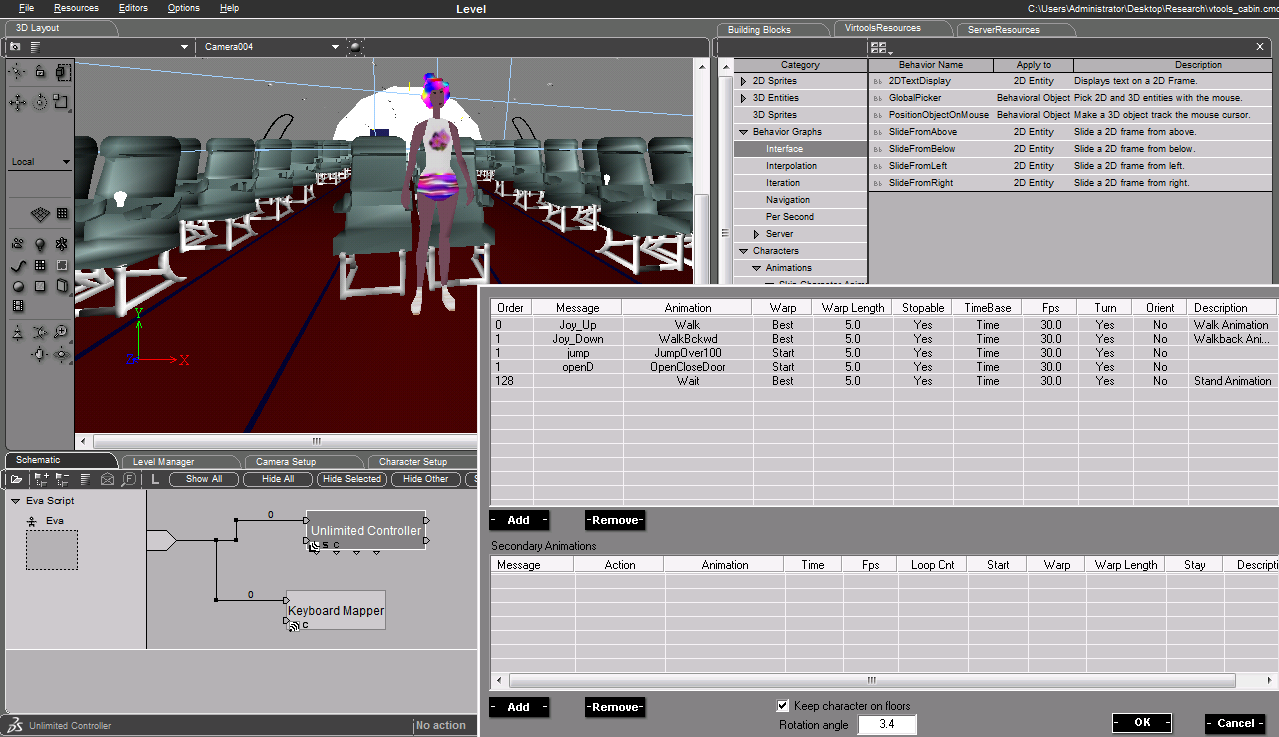
|
Development of a Virtual and Augmented Reality Laboratory for Research and Education at Bowie State University - will enhance the computer science and mathematics curriculum and increase research opportunities for undergraduate students by deploying Virtual and Augmented Reality (VAR) as a research and educational vehicle to immerse students in research and critical thinking challenges. The students will gain experience by using state-of-the-art VR equipment, software and technologies including 3D Wall, Head Mounted Display (HMD) that allows students to visualize complex data in three dimensional (3D) objects, working in 3D space to solve complex spatial problems, and conducting novel research through course work and research experience in the laboratory. |
| |
|


|
Simulation and Evacuation of Dulles
Airport Passengers in Emergency Scenario
The projects goal is to present the Washington Dulles International Airport (IAD) in a Virtual Reality enviorment. The airport is situated in Chantilly, Virginia, USA. This application can be used for training a future pilot. It could also be used as an educational and training tool for depicting emergency scenarios. We will explore emergency scenarios both inside and outside the airport. Inside the airport the behaviors are evacuation, collective, cooperative, and selfish behaviors. Outside the airport we will model and simulate: Precautions during flight take off, Plane taking-off on a runway with snow, Undesirable object like bird comes in the way of flight, Bird hitting the engine during take-off, etc. |
| |
|
| |
Simulating
and Modeling of Bowie State University's Library for Navigation and Evacuation |
 |
The main goal of this application is
to aid the visitors and to present VR as a tool for educational
and training. This project presents the simulation and modeling
of a Bowie State University library building in a virtual
environment. The development of virtual reality environment
makes it possible for a user to understand and observe multiple
paths that an agent would observe during navigation and evacuation.
This environment can be used via the web or through a physical
kiosk placed at the entrance of the building. This application
can also be used to simulate the evacuation behavior inside
the building. |
| |
|
| |
Rovio Robot
for Surveillance in Emergencies |
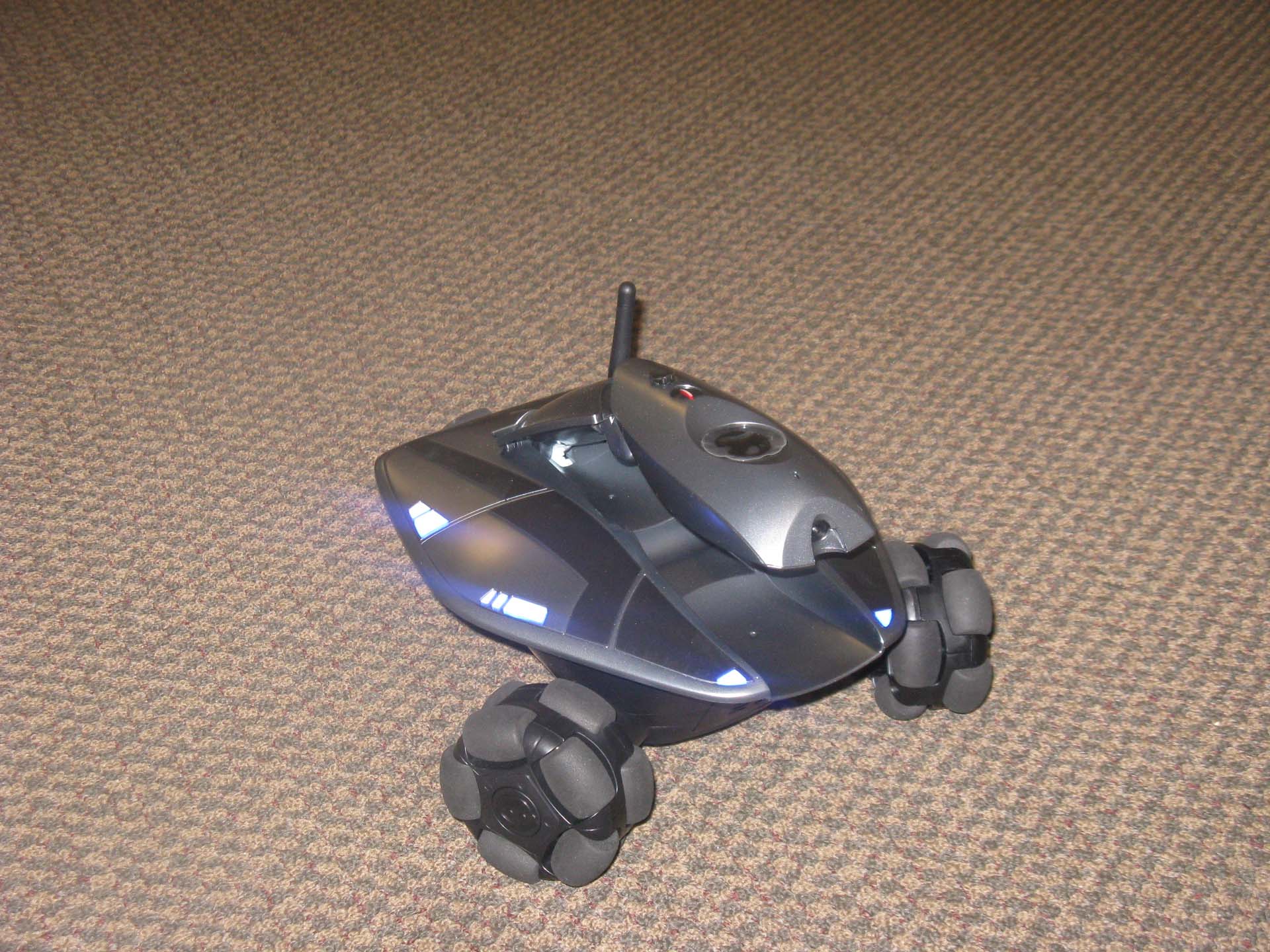 |
Rovio is a Wi-Fi enabled mobile webcam
that lets you view and interact with the environment through
streaming video and audio. Rovio can be remotely accessed
from PC or Mac, cell phone, smartphone, PDA or even a video
game console with an internet connection. Our research focuses
on dispatching rovio to the threat location to collect data
and exchange messages with other mobile/ static sensors. Our
work also focuses on wireless mesh network (WSN), intelligent
fuzzy interface system, real-time video stream data fusion,
background modeling and anomaly detection. |
| |
|
| |
Modeling and
Simulation of Crowd Behavior |
 |
Many research and social interaction aspects of crowd
behavior are beyond the reach of available tools. The VR environment
is able to adapt for specific design situations and provide
insight to current perspective as well as what-if questions.
Our hypothesis is that mutual concern, helping, and co-ordination
will more likely occur when crowd members share a common identity.
The selfish behavior associated with 'mass panic' may occur
in evacuation if there is no shared identity. Our hypothesis
is that the visualization studies support the conclusion that,
where there is a strong sense of collective identity, there
will be mutual concern and helping. |
| |
|
| |
Evacuation
Simulation and Embedded Videos |
 |
This project presents evacuation simulation
of a school building using virtual reality. It is well known
that crowd stampede is one of the most disastrous forms of
collective behavior caused due to panic. It leads to fatalities
as people get trampled and crushed as they fall. The application
presents a school building environment with several classrooms
with students, teachers, chairs, televisions, walls, doors
and tables.This simulation aims to aid the visitors in navigation
within the building. |
| |
|
| |
Virtual
Reality Museum as a Tool for Learning and Education |
 |
The ability of Virtual Reality (VR) to
explain the principles of design, manufacturing and business
far surpasses that of books. Virtual environments (VE) provide
facility for experiential learning by allowing the students
to explore the VE at their own pace and interact in real time.
Game creation is used as a metaphor for early design education.
The VRML Museum project was conceived with the interest of
informing the public about the evolution of current manufacturing
systems. |
| |
|
